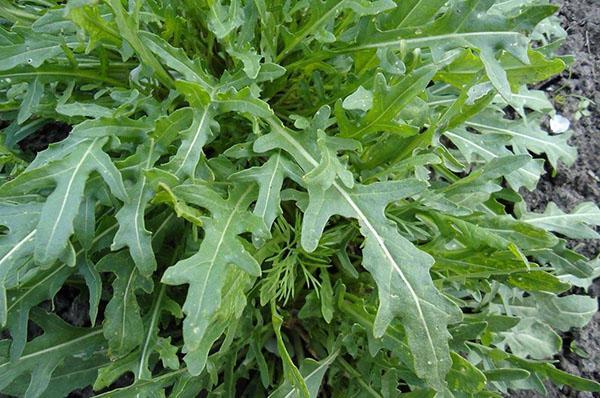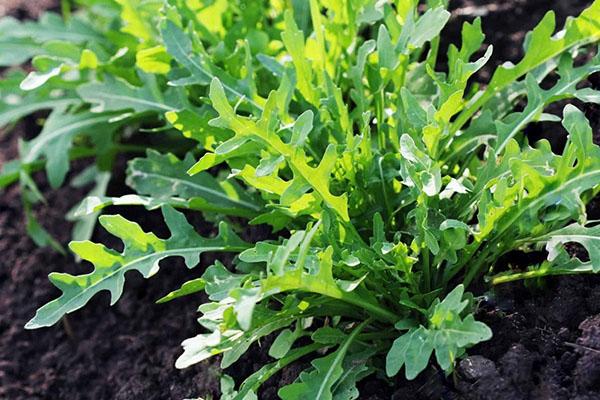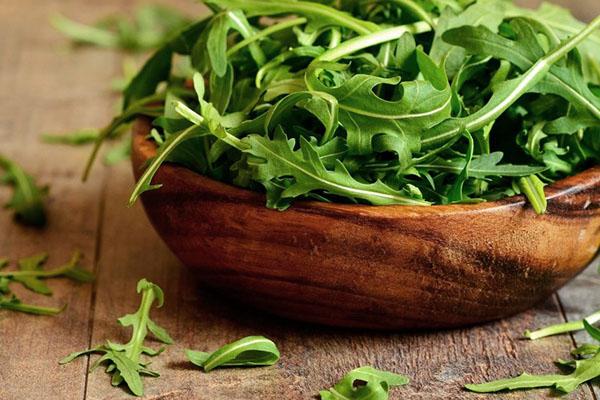Proper cultivation of arugula in the open field and after 20-30 days it is on your table

Nutritionists around the world recommend eating fried meat in tandem with juicy greens, which help the body digest it faster. However, products from the supermarket are rich in all kinds of nitrates, so housewives practice growing arugula in the open field in their country house. In order for the culture to acquire a rich nut-mustard taste, it is necessary to follow the rules of its agricultural technology.
Growing arugula in the open field: choosing a variety and a suitable place

The first step is to determine which variety will suit the grower's needs and expectations. Varieties of eruka (Latin name) differ in ripening period, leaf shape and taste.
Early maturing (harvesting is carried out in 20-25) include varieties:
- Poker;
- Koltivata;
- Olliveta;
- Rococo;
- Rocket;
- Tanagskaya Semko.

But the mid-season (from 30 to 38 days) are "Curiosity", "Victoria" and "Arrows of Cupid". Growing and caring for arugula outdoors begins with choosing a suitable place. The culture is planted in areas with diffused lighting.

Garden beds are fenced with plantings from:
- corn;
- beans;
- climbing plants (special trellises are installed for them).
Bright light and high temperature will lead to premature shrubs shooting. As a result, the leaves become coarse and taste like bitter wormwood.
The next step in growing arugula in the country is the choice of the required type of soil. The culture is sensitive to high soil acidity.

Therefore, it is planted in:
- slightly alkaline or neutral substrates;
- calcium-rich land (add chalk or dolomite flour);
- air and permeable soil mixtures.
It is worth remembering that the systematic application of mineral fertilizers significantly acidifies the soil. For this reason, in the fall, it is recommended to liming the site with its subsequent digging. Then, in the spring, before sowing, the land must be fertilized with nitrophos or kemira (35-40 g / m²).
During the growing season, it is not recommended to feed the planting. The main reason is that the leaves of the culture are able to quickly and in large quantities accumulate nitrate compounds. It is very unhealthy.
Place in the crop rotation. All legumes, peas, potatoes, tomatoes, zucchini, carrots and squash... Since the plant belongs to the Cruciferous family, then after it in the next 3-5 years it is not advised to sow cabbage, radish, watercress or mustard.
Sowing dates for arugula: the main thing is not to be late

Eruka is distinguished by its special early maturity, which allows it to be grown several times throughout the season. The gap between crops should be 10 to 14 days. This system is adhered to until mid-summer, and then re-planting at the end of August and until October. At the same time, this culture belongs to cold-resistant plants. Therefore, the question of when to plant arugula can be answered simply - as soon as the topsoil (10 cm) warms up to 6-10 ° C.
These terms differ in different regions:
- For the southern and middle lane, the sowing time is in mid-April.
- In the northern regions, spicy greens are grown using a greenhouse or seedling method.
- Sowing seeds for seedlings is carried out in March or early April.

Some people practice growing arugula in the winter in order to end up with a very early harvest. Sowing operations are planned for late October or early November. At this time, the air temperature should not rise above 0˚С. In addition, the likelihood of thaws will pass. Otherwise, the grains will swell and begin to sprout, which will lead to the death of the sprouts. As soon as the gardener has decided for himself when to sow arugula, you can directly start gardening.
Inhabitants of the southern provinces can plan for sowing eruki in February. To do this, they will have to wait out tolerable weather, a kind of February window for planting crops.
Agrotechnics of growing arugula and the subtleties of care for seedlings

Since cruciferous seeds germinate well enough, nothing needs to be done other than disinfecting the seed. The farmer will only need to soak the grains for 15 minutes in a weak solution of potassium permanganate, and then let them dry out a little.
When sowing arugula seeds, it is worth considering the main features of its agricultural technology:
- Row spacing - 30-45 cm.
- Embedding depth - 2-4 cm. It all depends on the density and looseness of the soil.
- Planned thinning. The distance between specimens should be 8-10 cm. The appearance of 2-3 full-fledged leaves is the time when you can dive arugula. Excess seedlings are not thrown away, but planted in separate containers for growing on the windowsill.
- Watering. The aisles are irrigated every 2 days in the morning (before 10:00) or in the evening (after 17:00). When the greens are saturated with moisture, they lose their pungent bitterness.
- Loosening and weed removal... This is a must when growing arugula from seeds. It is carried out regularly so that there is no thickening, which leads to the formation of fungal spores. Weeding provides air and moisture to the root system.

There are still disputes among agronomists about fertilizing. There is no definite answer. Since many do not recommend the use of mineral fertilizers, you can stop at the planned introduction of humus into the ground. Fertilizer is scattered around the garden before the autumn digging.
It is worth knowing that the result of growing arugula in the open field largely depends on the air temperature. The first shoots appear only at + 10˚С. To get fast and friendly shoots, warmer climatic conditions will be required - 17-23˚С.
Arugula pests and diseases: how to protect yourself and fight them

Cruciferous fleas and cabbage moth are especially dangerous for planting. The result of their work is small holes on the leaves, which spoil the presentability of the product and deprive the plant of strength.
The following means are used to combat them:
- seasonal digging of the site;
- sprinkling greens with ash, ground red pepper or tobacco powder;
- covering seedlings with lutrasil or spunbond;
- spraying sprouts with an infusion of wormwood or potato / tomato tops.

In addition, the foliage of the eruka may turn brown or yellow. These symptoms indicate the defeat of the culture by fungal infections - fusarium or peronoscosis. To protect your crop from such diseases, you need to follow the rules of crop rotation, as well as remove weeds in a timely manner.
The culmination of outdoor arugula cultivation is the collection of succulent leaves. Once they reach 10 cm, they are cut to the ground. If the bush releases a peduncle, then the taste of the salad is significantly reduced. Many mouth-watering dishes are prepared from this spicy bitter greens: vegetable, meat and fish. But how they do it is another story.